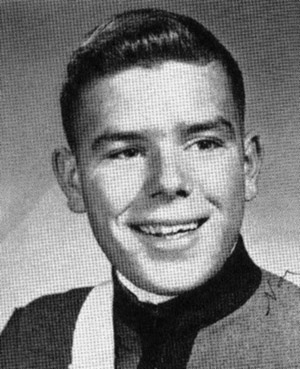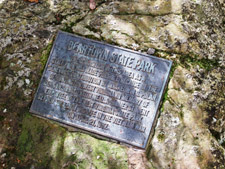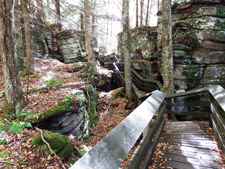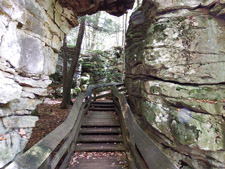

Remember...
Ronald Keith Neal
1946-1967
"But this too is true: stories can save us."
Tim O'Brien, The Things They Carried
 |
Remember...Ronald Keith Neal
|
Ronald Keith Neal was born to Dorothy Osborn Neal and Julian Weiland Neal on January 19, 1946. He was born in Charleston, but his hometown was Huntington, West Virginia. His father, Julian, a chief operator in the chemical industry, died in 1953. Dorothy Neal later remarried to Edwin Polan. Mr. Polan was the owner of Polan Industries, a maker of optics, gunsights, and cargo kits for packaging military hardware. ("Gallery: Do You Remember?" Huntington Herald-Dispatch, 6 September 2011, accessed 14 May 2018, http://www.herald-dispatch.com/multimedia/photo_galleries/photos_historical/gallery-do-you-remember----sept/article_3b9c46ca-6098-5c99-bf3a-d2d827daa91d.html.) Ronald had siblings: Julian Neal and Lisa Polan Bozic.
Ronald attended Marshall University. At some point, he worked as a student employee of the West Virginia state park system. He graduated from the Florida Military School while his family lived in Sebastian, Florida, from 1960 through 1963. School friend Alexander Nelon posted that Ronald Neal was a drummer, guitarist, and writer for the school paper. Nelon continued that Ronald Neal was an honor student and a competitive swimmer and diver. ("Ronald Keith Neal," Vietnam Veterans Memorial Fund, http://www.vvmf.org/Wall-of-Faces/37468/RONALD-K-NEAL?page=2#remembrances.) Ronald Neal enlisted in the Navy on April 27, 1964, with Ashland, Kentucky as the last point of entry into service.
Ronald Neal's service history, as found at the Naval Special Warfare Command site, states:
Ronald Neal was born on January 19, 1946. He enlisted in the U.S. Navy on April 27, 1964, and completed basic training at NTC San Diego, California, in July 1964. Neal next attended Radioman A School at NTC San Diego from August 1964 to April 1965, followed by Underwater Demolition Team Replacement Accession training with Class 035 at NAB Coronado, California, from April to September 1965. His next assignment was with Underwater Demolition Team ELEVEN (UDT-11) at NAB Coronado from September 1965 to October 1966, and during this time he deployed with his Team to Subic Bay in the Philippines from January to September 1966. ("In Honor of Our NSW History, Please Take a Moment to Read a Bit about a Fallen Shipmate," accessed 14 May 2018, https://ethoslive.wordpress.com/2015/04/22/in-honor-of-our-nsw-history-please-take-a-moment-to-read-a-bit-about-a-fallen-shipmate-2/).
Then Ronald Neal was selected for SEAL Team One in October 1966. Not long after his selection, he spoke on national television about the mission of the SEAL force. ("Huntington Man Killed in Vietnam," Charleston Gazette, 24 April 1967.) SEAL teams are legendary unconventional warfare operators whose origins were based in World War II and later permanently established by President John Kennedy in 1962. As their history page describes,
. . . today's SEALs embody in a single force the heritage, missions, capabilities, and combat lessons-learned of five daring groups that no longer exist but were crucial to Allied Victory in World War II and the conflict in Korea. These were (Army) Scouts and (Navy) Raiders, Naval Combat Demolition Units (NCDUs), Office of (S)trategic Services Operational Swimmers, Navy Underwater Demolition Teams (UDTs), and Motor Torpedo Boat Squadrons. ("Navy SEAL History," NavySEALs.com, accessed 14 May 2018, https://navyseals.com/nsw/navy-seal-history/.)
The SEAL name reflects the mission environment and the concept that the units would be effective in all environments-Sea, Air, Land. SEALs operated in the deltas, rivers, and canals, working to disrupt the enemy's maritime lines of communication. Their mission was to "conduct counter guerilla warfare and clandestine maritime operations." According to "Navy SEAL History":
Realizing the administration's favor of the Army's Green Berets, the Navy needed to determine its role within the Special Forces arena. In March of 1961, the Chief of Naval Operations recommended the establishment of guerrilla and counter-guerrilla units. These units would be able to operate from sea, air or land. This was the beginning [of] the official Navy SEALs. Many SEAL members came from the Navy's UDT units, who had already gained experience in commando warfare in Korea; however, the UDTs were still necessary to the Navy's amphibious force.The first two teams were on opposite coasts: Team Two in Little Creek, Virginia, and Team ONE in Coronado, California. The men of the newly formed SEAL teams were educated in such unconventional areas as hand-to-hand combat, high altitude parachuting, safecracking, demolitions and languages. Among the varied tools and weapons required by the teams was the AR-15 assault rifle, a new design that evolved into today's M-16. The SEALs attended UDT Replacement training and they spent some time cutting their teeth at a UDT Team. Upon making it to a SEAL Team, they would undergo a three-month SEAL Basic Indoctrination (SBI) training class at Camp Kerry in the Cuyamaca Mountains. After SBI training class, they would enter a platoon and train in platoon tactics (especially for the conflict in Vietnam).
Of particular relevance to the Ronald Neal story, from the Naval Special Warfare Command site:
The development of a robust riverine warfare capability during the Vietnam War produced the forerunner of the modern Special Warfare Combatant-craft Crewman. Mobile Support Teams provided combat craft support for SEAL operations, as did Patrol Boat, Riverine (PBR) and Swift Boat sailors. In February 1964, Boat Support Unit ONE was established under Naval Operations Support Group, Pacific to operate the newly reinstated Patrol Torpedo Fast (PTF) program and to operate high-speed craft in support of NSW forces. In late 1964 the first PTFs arrived in Danang, Vietnam. In 1965, Boat Support Squadron ONE began training Patrol Craft Fast crews for Vietnamese coastal patrol and interdiction operations. As the Vietnam mission expanded into the riverine environment, additional craft, tactics, and training evolved for riverine patrol and SEAL support.
The Naval monthly summaries developed during the Vietnam War have been declassified and are now available for review. The April 1967 summary describes the events that lead to the death of Ronald Neal operating under Mobile Riverine Task Force 116.
Ronald Keith Neal deployed with his team to Southeast Asia on April 4, 1967. His death notice in the Charleston Gazette on April 24 explains that Ronald Neal was there only two days before he was injured. The date of the attack, April 7, however, means that he was in Vietnam with his unit for perhaps three days before sustaining the injuries that would eventually lead to his death. Under the heading River Patrol Force Rung Sat Special Zone River Patrol Group,
. . .on 7 April, a SEAL reconnaissance team suffered heavy casualties while engaging an enemy unit near the mouth of the Vam Sat Riber [sic]. The SEALs were conducting reconnaissance by fire from their armored LCM-3 when the enemy opened from positions on the bank. As the SEALs began returning the enemy fire, an air burst just forward of the coxswain's position killed three SEALs and wounded 12 other Americans and two Vietnamese. The team then withdrew to the Soirap River in order to evacuate the wounded. (U. S. Naval Forces, Vietnam Monthly Historical Summary, April 1967, AD-A953 617, p. 1.)
In the April supplement, the event was summarized this way: "In the Rung Sat Special Zone three SEALs were killed when a Viet Cong mortar round burst above their armored LCM, showering the boat with shrapnel."
The description of the event was modified between the first issue and the supplement, when it was modified to say,
. . . on 7 April, a SEAL reconnaissance team suffered heavy casualties while engaging an enemy unit near the mouth of the Vam Sat River. The SEALs were conducting reconnaissance by fire from their armored LCM-3 when the enemy opened fire from positions on the bank. As the SEALs began returning the enemy fire, a mortar-burst just forward of the coxswain's position killed three SEALs-LTJG D. M. Mann, USN, Interior Communications Electrician Third Class D. E. Boston, USN, and Radioman Third Class R. K. Neal, USN-and wounded 12 other Americans and two Vietnamese. The team withdrew to the Soirap River in order to the evacuate the wounded. (U. S. Naval Forces, Vietnam Monthly Historical Summary Supplement, April 1967, AD-A953 639, p. 4.)
"Reconnaissance by fire" is a term that means that the SEALs were using a method of reconnaissance in which fire is placed on a suspected enemy position in order to cause the enemy to disclose his presence by moving or returning fire. (Dictionary of Military and Associated Terms, retrieved 24 May 2018, https://www.thefreedictionary.com/reconnaissance+by+fire.) The LCM-3 is a Landing Craft Mechanized or Mechanical. These are boats that are meant for carrying vehicles or cargo. The number designation tells the knowledgeable person something about the boat, such as how big it is, how heavy the cargo could be, and how it was powered. The LCM-3 had two different designs. The Higgins could carry up to 60,000 and the Bureau could carry up to 120,000 pounds. ("Landing Craft Mechanized," Vietnam War Wiki, accessed 14 May 2018, http://vietnamwar.wikia.com/wiki/Landing_Craft_Mechanized). The report doesn't say whether the SEALs were accompanying cargo or whether they had any mission other than to identify the enemy and confirm their positions. The report does say why the patrols were necessary. The river systems were being used to transport men and equipment as well as conduct other shipping activities, and these ships were under constant threat and documented attacks by the enemy. Those on riverine task forces dismantled underwater bombs, patrolled the river banks, and took action to protect shipping.
Ronald Neal was not killed on that day. He was wounded by shrapnel and died on April 21 at the 24th Evacuation Hospital in Long Binh, South Vietnam. ("Report of Casualty," Bureau of Naval Personnel, Department of the Navy, available on the Coffelt Database site.) He died of infections that arose due to the injuries caused by the shrapnel.
In 1970, his mother, Mrs. Polan, teamed with The Nature Conservancy to acquire approximately 110 acres in Greenbrier and Pocahontas Counties, near Droop Mountain Battlefield State Park, Marlinton, and Hillsboro, for the purpose of creating a state park as a memorial to Ronald Neal. -The park is known for its huge rock formations, and the half-mile boardwalk which loops through the most prominent of the structures. The rock formations are composed of Droop, or Pottsville, sandstone more than 300 million years old. Erosion and faults in the sandstone created the deep crevasses between the rocks. Another way of looking at the beautiful formations is as though the rocks were high rises and gaps between like the streets of a city. According to the article "Beartown," when "Ronald Keith Neal was a boy, he loved to explore the area's rocks." (Wonderful West Virginia Magazine, May 2015, p. 6.) It was perhaps a family property at some point.
Another source describes the mechanism of the creation of Beartown this way: 'The area was donated to the Nature Conservancy by a private landowner; in 1970 The Department of Natural Resources acquired the property and a few years thereafter designated it a state park." ("Beartown State Park," Pocahontas County Convention and Visitors Bureau, accessed 14 May 2018, https://pocahontascountywv.com/beartown_state_park.aspx.) According to this source, bears are seen in the area and do hibernate in or near Beartown. It was long said by area residents that the unique formations would make great bear dens.
 |
 |
 |
Images for Beartown State Park show the rugged natural beauty of the area by which Mrs. Polan wanted her son to be remembered. Courtesy Cynthia Mullens |
||
A memorial plaque appears near the entrance to the walkways, which reads as follows:
Beartown State Park
The acquisition of this area as a state park was made possible because of the generous contribution
by Mrs. Edwin G. Polan of Huntington, West Virginia, in memory of her son, Ronald Keith Neal,
a former student employee of the West Virginia State Park system who lost his life in the Vietnam War on April 21, 1967
On a recent visit, the parking lot was found full and the boardwalks busy. Several people stopped to read the plaque set into the rock that dedicates the state park to the memory of Ronald Keith Neal, a West Virginia veteran who will not be forgotten. In woods that were lonely and virtually timeless, he is often remembered amid the rocks that carry his name, a lasting memorial for a man whose life was cut so short.
President Lyndon B. Johnson also recognized SEAL Team One, in part due to the event on April 7, 1967, in the following Presidential Unit Citation:
For exceptionally meritorious and heroic service from 16 July 1966 to 31 August 1967, in the conduct of naval unconventional warfare operations against the Viet Cong in the Republic of Vietnam. Although often required to carry out their operations in treacherous and almost impenetrable mangrove swamps against overwhelming odds, SEAL TEAM ONE personnel maintained an aggressive operating schedule and were highly successful in gathering intelligence data and in interdicting Viet Cong operations. On one occasion, a six-man fire team ambushed one junk and two sampans, accounting for seven Viet Cong dead and the capture of valuable intelligence data. During this daring ambush, all members of the fire team remained in exposed, waist-deep mud and water in order to obtain clear fields of fire. As a result of their constant alertness and skillful reading of Viet Cong trail markers, patrols of SEAL TEAM ONE succeeded in discovering numerous well-concealed Viet Cong base camps and supply caches, and captured or destroyed over 228 tons of Viet Cong rice, as well as numerous river craft, weapons, buildings, and documents. The outstanding esprit de corps of the men of this unit was evidenced on 7 October 1966 when a direct hit by an enemy mortar round wounded sixteen of the nineteen men aboard the detachment's armed LCM, and again on 7 April 1967 when three members of the SEAL TEAM ONE LCM were killed and eleven were wounded in a fire fight with Viet Cong positioned along the banks of a narrow stream. On both occasions, SEAL TEAM ONE men who were able, even though seriously wounded, returned to their positions and continued to fire their weapons until the boat was out of danger, thereby helping to save the lives of their comrades. The heroic achievements of SEAL TEAM ONE reflect the outstanding professionalism, valor, teamwork, and selfless dedication of the unit's officers and men. Their performance was in keeping with the highest traditions of the United States Naval Service.LYNDON B. JOHNSON (Lyndon B. Johnson: "Presidential Unit Citation Awarded to SEAL TEAM ONE, USN," November 11, 1968. Online by Gerhard Peters and John T. Woolley, The American Presidency Project. http://www.presidency.ucsb.edu/ws/?pid=29231.)
Article prepared by Cynthia Mullens
October 2017

West Virginia Archives and History welcomes any additional information that can be provided about these veterans, including photographs, family names, letters and other relevant personal history.